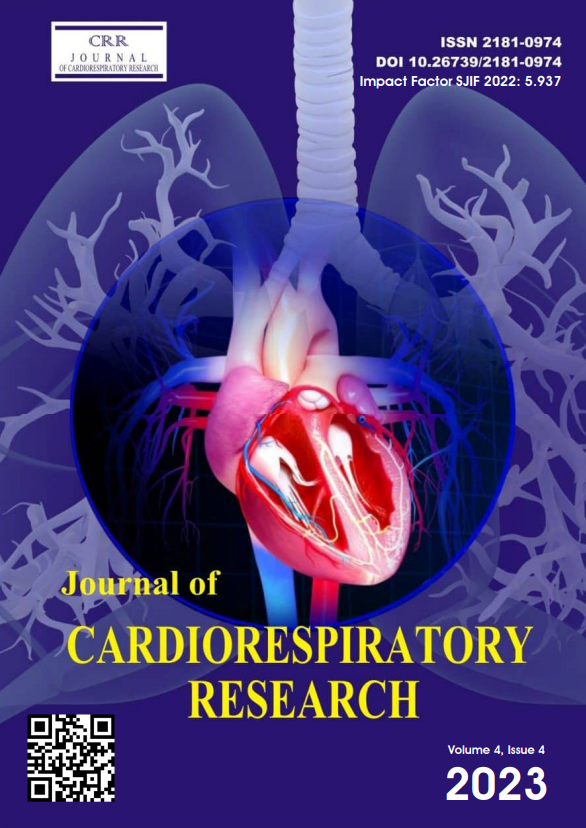ОСОБЕННОСТИ ЛЕЧЕНИЯ АНТИТРОМБОТИЧЕСКИМИ И АНТИКОАГУЛЯНТНЫМИ ПРЕПАРАТАМИ У БОЛЬНЫХ С ОСТРОМ КОРОНАРНОМ СИНДРОМОМ БЕЗ ПОДЪЕМА СЕГМЕНТА ST
Ключевые слова:
антитромботические препараты, антикоагульянты, острый коронарный синдром, анемия, кровотечениеАннотация
В настоящее время в лечении больных с острым коронарным синдромом без подъема сегмента ST (ОКСБПSТ) широко используются антитромботические и антикоагулянтные препараты. В ряде случаев лечение больных с ОКСБПST антитромботическими и антикоагулянтными препаратами повышает риск развития кровотечений.
Цель научного исследования, изучить лечению у больных с ОКСБПST, имеющийся высокий риск кровотечений и железодефицитной анемии. Проанализировано 112 истории болезней с диагнозом ОКСБПST, в отделении Кардиореанимации Республиканского научного центра экстренной медицинской помощи Самаркандского филиала. Мы изучили, течение болезни у больных с анемией. В лечение у 35 больных мы не исспользовали совместные применение антиромботические и антикоагулянтные препараты.
Библиографические ссылки
Alexander K. Р., Peterson E. D. Minimizing the risks of anticoagulants and platelet inhibitors. Circulation 2010; 121 (17): 1960—1970.
Anand I., McMurray J. J., Whitmore J. Anemia and its relationship to clinical outcome in heart failure. Circulation 2014; 110: 149—154.
Eikelboom J. W., Mehta S. R., Anand S. S. et al. impact of bleeding on prognosis in patients with acute coronary syndromes. Circulation 2016; 114: 774—782.
Fragmin during Instability in Coronary Artery Disease (FRISC) study group. Low-molecular-weight heparin during instability in coronary artery disease. Lancet 1996; 347 (9001): 561—568.
Ix J. H., de Boer I. H., Wassel C. L. et al. Urinary creatinine excretion rate and mortality in persons with coronary artery disease: the Heart and Soul Study. Circulation 2020; 121 (11): 1295—1303.
Lagerqvist В., Kontny F. 5-year outcomes in the FRISC-II randomised trial of an invasive versus a non-invasive strategy in non-ST-elevation acute coronary syndrome: a follow-up study. Lancet 2016; 368: 998—1004.
Meneveau N., Schiele F., Seronde M. F. et al. Anemia for risk assessment of patients with acute coronary syndromes. Am. J. Cardiol. 2019; 103 (4): 442—447.
Musted S. Evidence-based prescribing and adherence to antiplatelet therapy-how much difference do they make to patients with atherothrombosis? Int. J. Cardiol. 2019; 134 (2): 150—159.
Nancy M., La Pointe A., Pharm D. et al. Enoxaparin dosing and associated risk of in-hospital bleeding and death in patients with non ST-segment elevation acute coronary syndromes. Arch. Internj. Med. 2017; 167 (14): 1539—1544.
Oler A., Whooley M. A., Oler J., Grady D. Adding heparin to aspirin reduces the incidence of myocardial infarction and death in patients with unstable angi-na. A meta-analysis. J.A.M.A. 1996; 276:811—815.
Subherwal S., Bach R. G., Chen A. Y. et al. Baseline risk of major bleeding in non-ST-segment-elevation myocardial infarction: the CRUSADE (Can Rapid risk stratification of Unstable angina patients Suppress AD verse outcomes with Early implementation of the ACC/AHA Guidelines) Bleeding Score. Circulation 2019; 119 (14): 1873—1882.
Yang X., Alexander K. P., Chen A. Y. CRUSADE Investigators. The implications of blood transfusions for patients with non-ST segment elevation acute coronary syndromes: results from the CRUSADE National Quality Improvement Initiative. J. Am. Coll. Cardiol. 2015; 46: 1490—1495.
Van der Hulst R. W., Zandstra D. F., Geraedts A. A. et al. Prevalence of Helicobacter pylori infection in stress-induced gastric mucosal injury. Intensive Care Med. 2011; 27 (1): 68—73.

